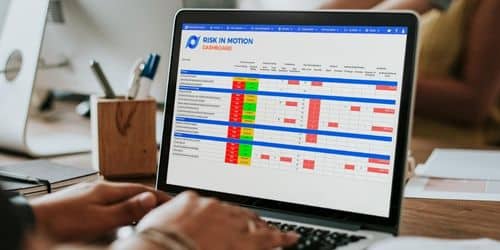Risk is uncertainty that might result in a negative outcome. Meanwhile, enterprise risk management systems talk about risks related to business. In this article, we mainly disclose details on solutions, companies, and frameworks concerning enterprise risk management.
A Broad Explanation of Enterprise Risk Management Systems
ERM systems adopt a comprehensive strategy and necessitate management-level decisions that might not be appropriate for every company unit or market area. Therefore, firm-wide oversight is prioritized over each business unit’s responsibility for its risk management. For instance, if a risk manager at an investment bank observes that two trading desks located in various departments of the company have comparable exposures, there is a chance that they will remove the less significant of the two from that particular position. Moreover, the entire business is considered before making this choice.
Enterprise risk management systems offer a framework for risk management, which often
- Entails identifying specific events or conditions pertaining to the organization’s objectives (threats and opportunities),
- Evaluating them for likelihood and impact,
- Choosing a response strategy, and
- Monitoring process.
However, businesses must protect and create value for their stakeholders, including
- Owners,
- Employees,
- Customers,
- Regulators, and
- Society at large,
This is achieved by recognizing and taking proactive measures to handle risks and opportunities. For instance, internal controls, the Sarbanes-Oxley Act, data protection, and SEC regulations.
What is Enterprise Risk?
A for-profit firm or business is referred to as an “enterprise” in other contexts, but it is most frequently connected to entrepreneurial endeavors. However, those who are successful in business are frequently referred to as “enterprising.”
What is Enterprise Risk Management?
Enterprise risk management (ERM) is a concept that examines risk management strategically from the viewpoint of the entire company or organization. In addition, it is a top-down strategy that tries to recognize, evaluate, and get ready for prospective losses, dangers, hazards, and other possibilities for harm that could obstruct an organization’s operations and goals or result that can lead to losses.
The Benefit of Enterprise Risk Management Systems
The supervision that enterprise risk management systems offer is one benefit because it covers all areas of organizational risk exposure, including
- Financial,
- Operational
- Reporting and
- Compliance
Enterprise Risk Management systems significantly increase your capacity to respond to the organizational challenges you face. And this includes providing teams on the ground with actionable, real-time data. In addition, it requires offering the board a 30,000-foot view of risk.
#1. ERM Improves the Capacity to Satisfy Legal and Regulatory Standards.
Enterprise Risk Management systems ensure you are in a position to meet reporting requirements and other regulatory requirements. Moreover, by implementing ERM, the danger of regulatory compliance violations can reduce. This is because it provides you with the information to prove compliance and the confidence that all threats are effectively dealt with.
#2. It Gives You More Assurance That You Can Accomplish Your Strategic Goals.
Your objectives become attainable when you’re sure you can identify and manage all the risks that could jeopardize your strategic goals. This gives you the opportunity to prepare for every potential curveball and take action to lessen its impact. Enterprise Risk Management also enables unambiguous risk oversight for the leadership.
Therefore by communicating this holistic view, you can present a risk to leadership in a way they value, and easily demonstrate how risk affects your entire organization.
#3. Your Operations Are More Efficient and Effective.
Operations are more efficient and successful when you evaluate risk holistically. Especially in the context of all internal and external environments, systems, conditions, and stakeholders, there should be no isolation from other factors. Your ability to consistently identify, assess, and monitor risks before they become an issue depends on having a clear framework for managing all risks.
However, depending on whether they are quantitative or qualitative, strategic, financial, IT-related, or third-party. Throughout your organization, you may proactively identify and address hazards.
Enterprise Risk Management Frameworks
The Enterprise Risk Management Frameworks are methods of evaluating risks that are likely to occur. This framework intends to assist in achieving the department’s priorities, which an organization will also outline in the strategic plan.
What are enterprise risk management frameworks?
Frameworks for enterprise risk management (ERM) are structures that enable
- Integrating,
- Creating
- Implementing
- Assessing
- Improving risk management
across the company” in ISO (International Organization for Standardization). Moreover, these frameworks demonstrate how important it is for senior management to create guidelines and offer leadership.
Types of Enterprise Risk Management Frameworks
- The Casualty Actuarial Society (CAS) ERM Frameworks
- The COSO ERM Integrated Frameworks
- The ISO 31000 ERM Frameworks
- The COBIT ERM Framework
- The NIST ERM Frameworks
- RIMS Risk Maturity Model ERM
Steps to Consider When Establishing Enterprise Risk Management Frameworks
#1. Common Language Around Risk
You must establish and effectively communicate a standard vocabulary with the organization through the risk management department (or equivalent). Moreover, establishing this can prevent losing money, which could prevent a company from achieving its goals. Therefore, Interbusiness communication will be made easier by using a common vocabulary.
#2. Risk Management Steering Committee
To oversee the use of the ERM Framework, it is crucial to create a high management level committee. The committee will also aid in defining the positions and duties within the Framework.
#3. ERM Methodology
To create an ERM Framework approach, you should include
- Explanations of roles and duties;
- Definitions of important risk terminologies; and
- Guidelines, such as, identifying, measuring, mitigating, monitoring, and reporting risks.
#4. Risk Appetite Statements
A formal document that enumerates each of the important economic sectors. The document should also consider the strategic goals and direction of the company. The firm’s ability to accept risk and its tolerance for potential loss should be precisely stated in this document. The senior management team and board of directors must also assess and approve a risk appetite on a regular basis.
#5. Risk Identification
Using the risk control self-assessment (RCSA) method, subject-matter experts can be included in the process, which risk management coordinates. This method uses a risk taxonomy to determine applicable hazards, inherent risk levels, the effectiveness of internal controls, and residual risk levels. The following are the steps in the procedure:
- Determine the risks that apply and explain the business activity that subjects the business unit to the risk. This also covers operational, event, liquidity, credit, market, and strategic risk.
- Determine the annual damage average and the inherent risk level (H, M, or L). Any obstacle to achieving company goals without taking internal controls into account is considered an inherent risk. The business unit’s subjective assessment, taking into account both past (actual losses) and probable future occurrences, might be an accomplice to estimating the typical yearly damage, if appropriate.
- Evaluate and also score the level of internal controls (H, M, and L), along with the assessment’s justification. Internal controls entail the use of policies, procedures, and standards to reduce the inherent risk.
- Determine the remaining risk level (H, M, or L) by using the formulas below
#6. Risk Prioritization
Determine the relative importance of the major risks based on the residual risk levels using the RCSA data for each business unit. Furthermore, set up risk mitigation plans and discuss any high residual risks with the Risk Management Steering Committee.
#7. Risk Mitigation Plans (RMPs)
To address the areas with the highest control inadequacies and the greatest potential for loss, You must design RMPs using a risk-based approach.
The high-risk things must be prioritized since businesses typically run out of resources before they run out of risk. To make the risk mitigation process easier, then you must choose accountable owners and target completion dates.
#8. Risk Monitoring and Reporting
The board of directors and senior management must be updated on the status of the major risks that were identified. However, creating an ERM Framework is a continuous process that involves many people.
Therefore, participation from all departments within the company is necessary for this rigorous, dynamic, and ongoing process. ERM will bring the organization various advantages when it is correctly implemented. ERM Framework that works will:
- Enabling a business to understand its overall risk exposure
- Increasing firm-wide awareness of risks and controls
- Cut back on operational losses
- Maximize the use of capital
- Match risk tolerance and strategy (business objectives)
- Board and senior management oversight is easier.
- Break down silos across all risks and among multiple departments (promote transparency).
- Allow for the more effective utilization of resources.
- Also enhancing perceptions among shareholders, rating agencies, and regulators.
- Improving internal control
- Encourage the culture of risk awareness.
It is therefore shocking to learn that just 36% of the institutions taking part in Deloitte’s Sixth Global Risk Management Survey have an ERM program in place after taking into account the advantages of implementing an ERM Framework. However, 72% of respondents said that ERM’s advantages outweigh its drawbacks.
Enterprise Risk Management Solutions Companies
#1. Enterprise Risk Management (ERM) Solutions
This is a business consultancy organization (ERM). The ERM Solutions company, founded in 2010, offers expert services devoted to promoting, accepting, and using enterprise risk management technologies and techniques.
They assist businesses of any size in putting an efficient ERM process into action that is adaptable to your growth goals, risk environment, and corporate culture. Moreover, organizations can reach their full potential by recognizing and proactively managing the risks that surround them and their goals.
With their low-impact, high-return strategy, Enterprise Risk Management Solutions can infuse the value of ERM into your company. When it comes to ERM Solutions, they put their passion, quality, and value to work for you.
#2. The MetricStream Enterprise Risk Management App
The Enterprise Risk Management App by MetricStream Solutions Company can provide the highest level of efficiency for your ERM program.
Moreover, the app provides an accurate understanding of risks throughout the organization and clear visibility into the top risks by supporting uniform risk assessment techniques and standards. Companies can manage organizational risks in a disciplined and methodical manner thanks to this software.
#3. Essential ERM
Essential ERM by Tracker Network is a solutions company that offers solutions to enterprise risk management. It is software designed specifically for managing organizational risks. With this solution, you can easily track risks by objective, business area, and more. However, Your risks are dynamically ranked in an intuitive drag-and-drop environment.
Essential ERM is simple to use for both users and system administrators. The system takes a realistic approach to risk management, delivering robust features and conforming with COSO and ISO risk frameworks while limiting and/or disguising complexity for system users. The system offers dynamic reporting as well as the ability to export data to Excel and other reporting tools.
#4. Protecht
Protecht.ERM is a flexible platform for corporate risk management that has all the tools you need to manage risks, compliance, health and safety, internal audits, incidents, and KRIs. Moreover, for your entire organization, this program provides a centralized group risk assessment.
#5. Camms
Camms is a company that offers solutions to enterprise risk management. It is also a business software that may help you manage risks, align the talents of your organization, and concentrate on what counts by providing integrated solutions in risk, strategy, projects, and people.
In addition, Camms have spent continuously over the course of their nearly 25 years of experience to make sure that their software helps organizations reach their objectives.
What Are the 3 Types of Enterprise Risk?
The theoretical ideal of ERM is seldom actually achieved, and probably not necessary to achieve for most companies in the short term
- Financial: for instance, interest rate, investment, credit, liquidity, asset market value
- Operational: for instance- technology, people/intellectual capital, political/regulatory
- Hazard: for instance- legal liability, property damage, natural catastrophe
- Strategic: for instance-poor planning and poor execution
What Are The 8 Components of ERM?
- COSO.
- The ERM model.
- Internal environment.
- Objective setting.
- Event identification.
- Risk assessment.
- riskriskriskriskriskrcontrolcontroliskrisk respcontrol
What Are ERM Applications?
A customizable solution that integrates operations with corporate strategy and makes use of analytics to increase transparency and risk awareness is necessary for efficient enterprise risk management.
Moreover, using a single, centralized platform, the enterprise risk management application (ERM) enables an organization to identify, assess, quantify, manage, and monitor enterprise risks. Through role-based dashboards and reporting, the platform enables enterprises to access real-time data on risk management initiatives. However, The application can be easily customized to satisfy an organization’s unique requirements for risk and control assessment.
What Are the Four Objectives of ERM?
- Strategic: These objectives are high-level and are aligned with an entity’s mission.
- Operations: These objectives refer to the effective and efficient use of resources.
- Reporting: These objectives surround an entity’s need for reliable reporting.
- Compliance: These objectives refer to an entity’s need to comply with applicable laws and regulations.
Who Is Responsible for Implementing ERM?
While every company has a different set of departments, in most cases the Board of Directors is given ultimate authority for ERM. The board must assess whether management is adequately identifying, assessing, and controlling all corporate risks.
How Do You Identify Risks in ERM?
Risk is the potential positive or negative impact of uncertainty on organizational and programmatic goals.
When a risk materializes, it could improve, hinder, compromise, hasten, or delay the attainment of goals. Risk assessment takes into account “future occurrences,” their origins, and their potential effects.
Therefore, to uncover potential future scenarios and uncertainties pertinent to corporate goals and/or development outcomes, risk identification needs to understand the context, historical risk patterns, and forward-looking thinking.
To make sure that you identify all pertinent risks, potential hazards from all of the ERM risk categories should be taken into account.
How is ERM Implemented in an Organization?
You can implement Enterprise risk management by following guidelines which include
- Risk mapping of specific risks,
- Risk assessment workshops, and
- Risk assessment interviews
The latter is a “best practice” because interviews are particularly successful at revealing how a business truly operates.
Stochastic risk models are a rigorous mathematical method for constructing cause-and-effect linkages between all the variables in a system to mimic the dynamics of that system.
However regular reporting to managers, boards, and pertinent external stakeholders, such as regulators and investors, might include in risk monitoring reports.
Because the research indicates that these reports are mostly “ad hoc” in nature nowadays. For instance, where reporting is more formal, the reports are more likely to go to the directors’ board and the executive committee. The least likely route for reports to reach operational managers is through “dashboards,” which would allow them to adapt their behavior to the reality of their risk environment.
Conclusion
The possibility of a negative outcome is known as risk. based on the department’s risk appetite and the context of our risk environment, ERM is a thorough strategy for discovering, assessing, and treating risk.
FAQs
What are the types of risk?
- Security and fraud risk.
- Compliance risk.
- Operational risk.
- Financial or economic risk.
- Reputational risk.
What is a risk management dashboard?
It is the graphical presentation of the organization’s critical risk measures (often against their respective tolerance levels); typically used in reports to senior management.
What is the difference between ERM and risk management?
And as we noted above, ERM encompasses the entire enterprise; and is top-down, whereas traditional risk management may focus on only one area, and not emanate from a holistic view of the entire organization
References
Related Articles
- Top Enterprise Risk Management Software: Features, Pros & Best 7 in 2023
- Enterprise Risk Management: Overview, Framework, Competencies
- MARKET RISKS: Best Practices and Easy Guide with Examples
- BUSINESS RISK: How to Manage Risks in Business
- INTERNAL CONTROLS: Meaning and Examples
- PROJECT PLANNER: 15 Best Project Planning Tools & Software in 2023






